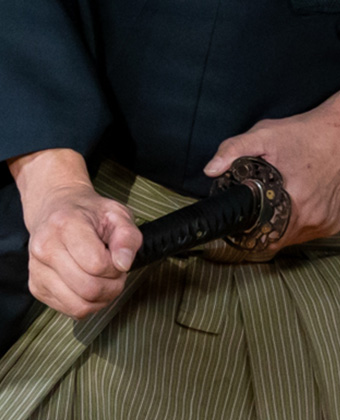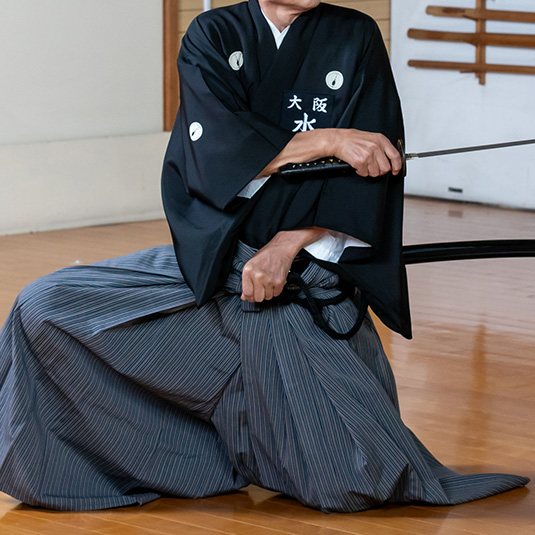居合道とは?
About “Iai-dou”

居合は刀の操法であると共に、護身の刀術です。
その心構えは、「人に切られず、人切らず」です。
抜刀術、抜刀兵法、居合術等、時代によって種々の名称が有りますが、現代では心の道を含め「居合道」と称されています。
「居合道」は、敵の攻撃に、殺気の攻めの段階から直ちに合わせ、抜刀し、鞘放れの瞬間で敵を倒す武道として創始されたものです。
「居合」の「居」は、諸所の場所に居る所、自ら体勢と動きを含め「居」とし、いわゆる「居」とは、その場その時の心身の実在を現しています。
「合」とは、いかなる敵の攻撃に、臨機応変に合わせ、直ちに勝つ刀術を現しています。
「居合道」は、静中に動きを得るところの静動の変化、精神修養の道であり、禅や茶道等の、礼、気位、作法にも相通ずるものが有ります。
「居合道」は、男女、年齢、段位に区別なく演武対戦し、その演武の出来映えで勝敗が決まる魅力があります。
日本の武士道文化を含め「居合道」その魅力から、外国の方々に日本国内外で多くの同好の士がおられます。
当会では、居合道の修練修得と心身の鍛錬を目指し、またそれを楽しむことを目標に稽古に励んでおります。
そして、大会入賞、段位合格、皆さんとの交流等で、楽しみを増幅しております。
“Iai” is a practice of drawing a sword and also a martial art for self-defense.
The concept is “not to be killed and do not kill others”.
There are several names like “Battou-Jyutsu”, “Battou-Heihou” or “Iai-Jyutsu”, but, today, it is all called “Iai-Dou”, emphasizing a way of mind.
“Iai-Dou” was first developed as a martial art, where one tunes in the enemy’s murderous intent, prepares for an attack, rapidly draws a sword in response to the attack and kills the enemy.
“I” in “Iai” means a place where one exists at and also one’s posture and movement, and it represents the presence of the mind and body at that time.
“ai” in “Iai” represents a sword art, where one flexibly responds to an attack and wins right away.
“Iai-Dou” is a change in stillness and movement, where one takes an action in stillness and also a way of mental training, which is similar to manner, moral and courtesy in “Zen” and “Japanese tea ceremony”.
“Iai-Dou” is attractive as people with any gender, age and level can perform “En-Bu” (i.e., showing one’s sword-drawing skills in front of audience) and the win or lose is determined by the quality of “En-Bu”.
There are many people who practice “Iai-Dou” not only in Japan but also all over the world due to its attractiveness including culture of Japanese “Bushi-Dou”.
In this club, we strive to practice “Iai-Dou” and to train our minds and bodies, and to enjoy them.
We enjoy our activities through placing in a competition, passing the rank and interaction with members.
無双直伝英信流について
About “Musou Jikiden Hidenobu-ryu”

当流の始祖は、室町時代の末期から戦国の時代、永禄年間(1558~1570)抜刀術の達人と称せられた、奥州(山形県) 足利の子孫「林崎甚助源重信」であり、「林崎夢想流」と唱せられました。
その後江戸時代へ入り、享保年間(1716~1736) 正統第七代宗家「長谷川主税助英信」が、始祖以来の名人で、古伝の業に独創の技を加へ「無双直伝英信流」と改められました。
始祖の室町時代は、刀を腰帯に差すことなく佩刀し、刃が下を向いており、野戦を主とした居合であったと推測されます。
江戸時代に入り、社会情勢、生活様式も変わり、現在継承されている刃が上を向く帯刀となり、武士の家も畳を敷く生活から正坐にもなり、「長谷川主税助英信」は、これに応じた業を工夫し加えたと考えられています。
そして、第八代宗家「荒井勢哲清信」に、土佐山内家の藩士「林六太夫守政」が江戸勤番中に学び、第九代を継承し、土佐の国(高知県)山内藩に門外不出、戦いの秘術、お止流として口伝で伝承されました。
そして昭和の初め、(1926〜)に、正統第十八代宗家「穂岐山波雄」を講師として大阪武徳会大阪支部に招聘し、教えを受けました。
引き続き、正統第十九代宗家「福井春政鉄骨」に、指導を受けました。
八重垣会の二十周年の昭和二十五年(1950)春 大阪在住の「河野稔百錬」が、正統第二十代宗家を継承されました。
The founder of this school was the descendant of Oshu (Yamagata Prefecture) Ashikaga, called "Hayashizaki Jinsuke Minamotono Shigenobu", who was called a master of “Batto-Jutsu” during the Eiroku era (1558 ~ 1570) from the end of the Muromachi period to the Sengoku period, and his “Batto-Jutsu” was said to be " Hayashizaki Musou-ryu".
Later, in the Kyoho era (1716 ~ 1736) during the Edo period, the 7th head family "Hasegawa Chikara-no-suke Hidenobu", who was regarded as the great master since the founder, added original techniques to the ancient arts and named his “Batto-Jutsu” "Musou Jikiden Hidenobu-ryu".
In the Muromachi Period, when the originator of our school was alive, people carried a sword without putting it in his waistband, and the edge of the sword faced down, so it is assumed that it was “Iai” mainly for open battle.
In the Edo period, because social conditions and lifestyles changed (e.g., wearing a sword with the blade facing up as in the present style, and Samurai started to sit Seiza-style as there are Tatami matts in the house), it is thought that "Hasegawa Chikara-no-suke Hidenobu" created new techniques in response to these changes and added those to his practice.
During Edo Kinban, a feudal retainer of the Tosa Yamauchi family called "Hayashi Rokudayu Morimasa" learned from the eighth head family "Arai Seitetsu Kiyonobu" and succeeded to the ninth head. The style was passed down by word of mouth in the Yamauchi domain of the Tosa province (Kochi Prefecture) as a secret art of warfare.
At the beginning of the Showa period (1926 ~), we invited the 18th legitimate head family "Hokiyama Namio" as a lecturer to the Osaka branch of the Osaka Butoku Kai, where we had a lesson..
We continued to receive guidance from the 19th head family "Fukui Harumasa Tekkotsu“.
In the spring of 1950, the 20-year anniversary of the Yaegaki-kai, "Kono Minoru Hyakuren" living in Osaka was succeeded as the legitimate 20th head family.
無双直伝英信流 居合種目(42本)
“Musou Jikiden Eishin-ryu” “Iai-syumoku”(i.e.,Iai events) (a total of 42 evens)
-
第1、正坐之部(11本)
*正座の体勢からの技(は立つ体勢から)
- 前
- 右
- 左
- 後
- 八重垣
- 受流
- 介錯
- 附込
- 月影
- 追風
- 抜打
-
第2、立膝之部(10本)
*立膝の体勢からの技(は正座の体勢から)
- 横雲
- 虎一足
- 稲妻
- 浮雲
- 颪
- 岩浪
- 鱗返
- 浪返
- 瀧落
- 真向
-
第3、奥居合、居業之部(8本)
*立膝の体勢からの技(は立つ体勢から)
- 霞
- 脛囲
- 戸詰
- 戸脇
- 四方切
- 棚下
- 両詰
- 虎走
-
第4、奥居合、立業之部(13本)
*立つの体勢からの技(は正座の体勢から)
- 行連
- 連達
- 惣捲
- 惣留
- 信夫
- 行違
- 袖摺返
- 門入
- 壁添
- 受流
- 暇 乞一、二、三
-
“Seiza no bu” (11 events)
Skills from a posture of “Seiza” (from a standing posture for 10)
- Mae
- Migi
- Hidari
- Ushiro
- Yaegaki
- Uke-nagashi
- Kai-syaku
- Tsuke-komi
- Tsuki-kage
- Oi-kaze
- Nuki-uchi
-
“Tate-hiza no bu” (10 events)
Skills from a posture of “Tate-hiza” (from a posture of “Seiza” for 10)
- Yoko-Gumo
- Torano-issoku
- Ina-zuma
- Uki-gumo
- Oroshi
- Iwa-nami
- Uroko-gaeshi
- Nami-gaeshi
- Taki-otoshi
- Makkou
-
"Oku-iai, I-waza no bu" (13 events)
Skills from a posture of "Tate-hiza" (from a posture of standing for 8)
- Kasumi
- Sune-gakoi
- To-dume
- To-waki
- Shihou-giri
- Tana-shita
- Ryou-dume
- Tora-bashiri
-
"Oku-iai, Tachi-waza no bu" (13 events)
Skills from a posture of standing (from a posture of "Seiza" for 11)
- Yuki-dzure
- Tsure-dachi
- Sou-makuri
- Sou-dome
- Shino-bu
- Yuki-chigai
- Sode-suri-gaeshi
- Mon-iri
- Kabe-zoe
- Uke-nagashi
- Itoma-goi Ichi, Itoma-goi Ni, Itoma-goi San,
無双直伝英信流 居合道形(18本)
“Musou Jikiden Eishin-ryu” “IaiDo-kata” (a total of 18 evens)
*二人で対峙する組太刀で、攻める方を打太刀、技を出す方を仕太刀という。
It is performed by a pair, where the offender is called "Uchi-tachi" and the defender/one who shows the skill is called "Shi-tachi".
*立膝之部、居業之部の立膝の座り形は、「甲冑居合」「陣中居合」と言われ、また、無双直伝英信流の立膝の構えは、右手に軍扇を持つとし、これを「殿様居合」とも伝へられています。
The style of sitting in "Tate-hiza" in the "Tate-hiza no bu" and the Iwaza no bu" is called "Kacchu Iai" or "Jinchu Iai" and the posture of "Tate-hiza" of "Musou Jikiden Eishin-ryu" is said to hold a “Gunsen”(i.e.,war-fan) in the right hand, which is also said to be "Tono-sama Iai".
-
第1、太刀打之位(7本)
*二人が立って対峙から
- 出合
- 拳取
- 絶妙剣
- 独妙剣
- 鍔留
- 受流
- 真方
-
第2、詰合之位(11本)
*二人が立膝の体勢で対峙から(は仕太刀が立膝から)
- 発早
- 拳取
- 岩浪
- 八重垣
- 鱗返
- 位弛
- 燕返
- 眼関落
- 水月刀
- 霞剣
- 討込
-
"Tachi-uchi no Kurai" (7 events)
From a starting position, where two people stand up and face to each other.
- De-ai
- Kobushu-tori or Ken-tori
- Zetsu-myou-ken
- Doku-myou-ken
- Tsuba-dome
- Uke-nagashi
- Ma-ppou
-
"Tsume-ai no kurai" (11 events)
From a starting position, where two people face to each other with a posture of "Tate-hiza" ("Shi-tachi" takes a posture of "Tate-hiza" in 6)
- Ha-ssou
- Kobushu-tori or Ken-tori
- Iwa-nami
- Yaegaki
- Uroko-gaeshi
- Kurai-yurumi
- Tsubame-gaeshi
- Gan-seki-otoshi
- Sui-getsu-tou
- Kasumi-ken
- Uchi-komi
